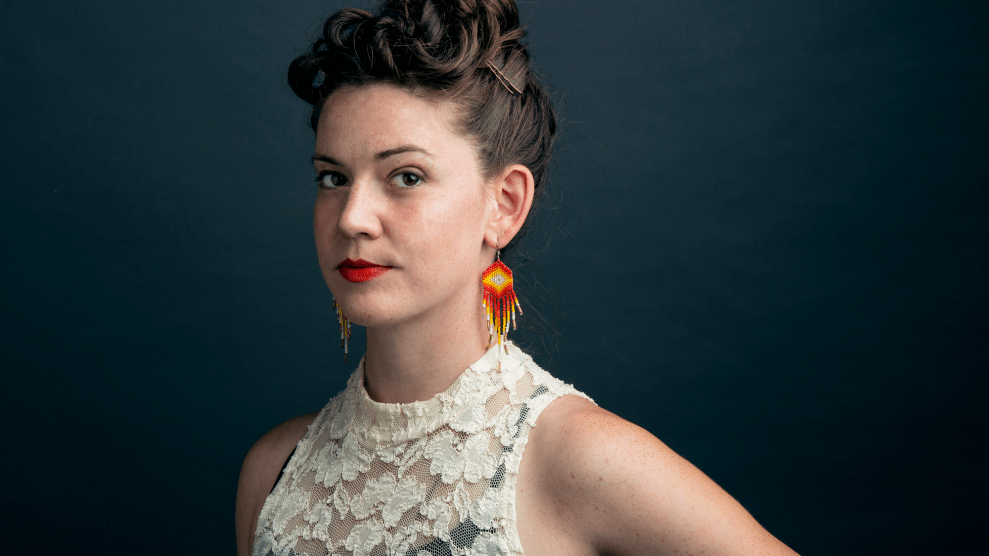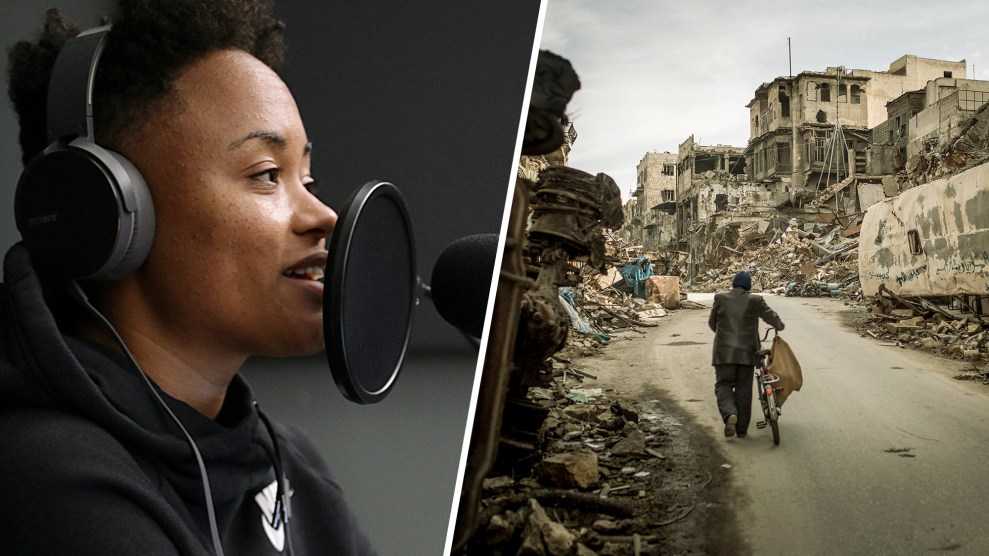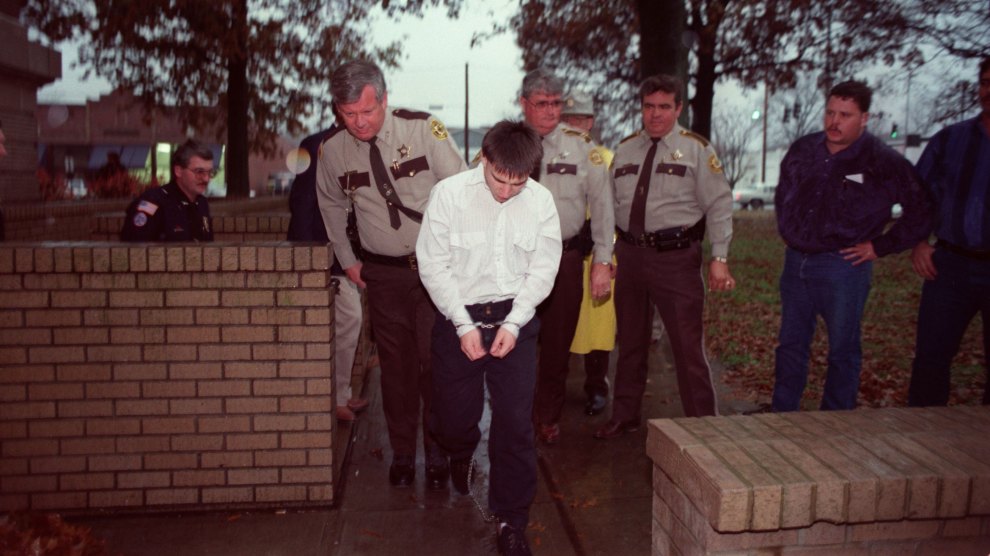I was walking down the street wearing big headphones. I wear them everywhere, like many women, trans, and queer people I know, to avoid hearing men’s street harassment. And in my headphones I was listening to a Dateline NBC podcast episode about a woman being murdered. It struck me as kind of sick—listening to stories of women’s suffering for my enjoyment in order to avoid a milder form of suffering in the real world. But that’s the appeal of the true crime genre: We like it because it confirms that the world is dangerous and bad. But unlike the real world, in which men harass and assault and murder women, true crime can always be switched off.
My true crime fixation used to make me uncomfortable. Now I’ve accepted the addiction as part of my life. And that’s what it is—an addiction, something I keep ingesting even though I know it’s bad not only for me but for the world. It’s how the genre often describes itself. One of the most popular true crime podcasts is called Crime Junkie. Another is called True Crime Obsessed, which hints at the guilt we feel for consuming the stories of people, mostly white women, being murdered. We know it’s bad for us, and yet, like with any addiction, we keep going.
For more articles read aloud: download the Audm iPhone app.
Over half of Americans say they’re interested in true crime as a form of entertainment. Serial, the hit podcast spun off from This American Life in 2014, has racked up more than 340 million downloads. Netflix has released dozens of true crime documentaries, like Making a Murderer and more recently Killer Inside: The Mind of Aaron Hernandez. True crime junkies wear shirts that say things like “true crime, glass of wine, bed by nine,” attend true crime conferences and live podcast recordings, where audiences cheer as the hosts detail the offender du jour’s punishment, and even sail away on pricey true crime–themed cruises.
As I’ve become more comfortable with my own addiction to true crime, I’ve begun to fret more about the genre as a whole—especially now, as millions around the world rise up against a rotten system that surveils, jails, and ruins the lives of countless people of color. True crime has become not only a way to soothe our own anxieties but a method of recasting the world as fantasy: The bad cops in true crime tend to be the fascinating exceptions to the normal workings of the system, which itself is rarely questioned. The genre is the most dangerous kind of propaganda—it not only teaches us a lie but makes us feel safe, and maybe even just, while learning it.

Last year, the hosts of the megapopular podcast My Favorite Murder, Karen Kilgariff and Georgia Hardstark, released a book called Stay Sexy and Don’t Get Murdered. In it they argue that the same qualities they say can prevent you from being killed—sticking up for yourself, getting comfortable with being rude to men, not being a follower—are also the keys to happiness for women in work and relationships.
The book is semifunny, in a lobotomized kind of way, filled not so much with jokes as with joke-shaped objects. It can be summarized by its first chapter, “Fuck Politeness.” “Little girls are taught to be polite, to smile pretty and sit up straight, to be nice and accommodating,” the authors write. “And then those little girls turn into grown-ass women who’ve spent years being polite to the detriment of their own wants, needs, and safety.”
“Fuck politeness” is similar to the refrain in Crime Junkie, which, like MFM, is hosted by two women who summarize cases based on others’ original reporting: “Be Weird. Be Rude. Stay Alive.” Both slogans can now be found on a variety of merchandise, from hoodies to PopSockets. There are even people out there with “stay sexy, don’t get murdered” tattoos.
None of that is bad advice, necessarily: I, too, would like to be sexy and remain alive, and I am learning, through therapy and time, to be less polite to men, and not to feel guilty for putting my foot down or standing up for myself. But none of it is new advice; self-help books have been saying this stuff for decades. The difference is that the advice now comes wrapped in details of women being raped, abused, and killed.
A recent episode of Crime Junkie, consistently one of the most downloaded podcasts in the country, is typical of the genre. Hosts Ashley and Brit—Ashley Flowers and Brit Prawat, though the mood they establish is too casual for surnames—take listeners through the 1992 murder of Lisa Ziegert. Like the majority of the genre’s chosen victims, Ziegert was a young, conventionally attractive white woman. As suspenseful music plays quietly in the background, Ashley details Ziegert’s last day alive. A couple walks into the gift shop where Ziegert works in Agawam, Massachusetts. No one is there, but they hear muffled sounds coming from the back room. They leave and don’t call the cops.
“What?!” Brit asks incredulously.
“I know. I just couldn’t believe it. No one thinks the worst,” Ashley says, and then launches into a bit of self-help wisdom: “We talk all day, every day, about personal safety and being your own advocate. But we also have to look out for one another… We have to get out of our own heads and pay attention to what’s going on around us. Do it for others in hopes that one day, if you ever need it, someone will do the same for you.”
“That kinda sounds like a new Crime Junkie life rule, you know,” Brit says. “Pay attention and don’t be afraid to say something.”
“Another life rule,” Ashley says, “is that it’s okay to call the police.”
The rest of the episode reveals that Ziegert was abducted, raped, and murdered by a man named Gary Schara, who is now serving a life sentence. It wraps up with one final piece of advice from Ashley: “Her story is a reminder to all of us that evil is out there, sometimes in the most unsuspecting of places, and it doesn’t always look like what you picture.”
Lately, true crime podcasters have begun nodding to current events, perhaps aware that the dissonance between the stories they tell of good cops and a real world filled with police evil is growing too large to be sustainable.
On a recent episode of Crime Junkie, Ashley says that they started the show to tell stories of people whose voices have been taken away from them. “We stand in solidarity with the Black community,” she says. “Black Lives Matter.”
The sudden acknowledgement of politics after years of telling stories largely about white victims, based on uncritical accounts of police and prosecutors, is made all the more jarring by the fact that the rest of the episode goes on to tell the story of several girls who were murdered in Ohio, and several men who may have been unjustly convicted of their murders. As always, the crime victims get the top billing in the podcast. The people behind bars for crimes they did not commit still remain a very small subplot. Black lives matter—now back to the show.

Though stats are slim, the true crime audience appears to be overwhelmingly female. The podcast Wine and Crime reports that women make up 85 percent of its audience, which lines up with a 2018 study that found that 73 percent of true crime podcast listeners are women.
This gendered interest in the gory details of crime extends beyond media consumption. Women make up a relatively small percentage of law enforcement jobs, but they’re 78 percent of forensics students in the United States, more than double their rate in other science fields. As crime writer Rachel Monroe argues in her book Savage Appetites, women often enter forensics because of a past experience with trauma, whether it’s violence they’ve experienced or violence on a larger scale, like the September 11 attacks.
This makes some intuitive sense: When life feels out of control, people gravitate toward things that give them a sense of control. The narrative of policing and courts allows us to pretend there is order in our world: There are clear good guys, clear bad guys, and, hopefully, a tidy resolution—the bad guy gets caught; the victim, whether dead or alive, gets some semblance of justice. True crime, for the most part, does not challenge this narrative. While there are popular shows that investigate mistakes made by cops and judges, the vast majority treat the police as undeniable heroes, and frame punishment and imprisonment as a form of feminism: If only more men were behind bars, women could begin to thrive. Evil is out there. It’s okay to call the police.
There are no studies on the psychology of the true crime listener, but we can extrapolate from research and theories about horror movies. People like horror because it lets them experience violence and fear in a controlled environment. Mathias Clasen, a Danish professor who has extensively studied horror fans, argues that watching scary things allows us to trigger our fight-or-flight response while feeling safe, which in turn lets us feel as if we’re overcoming our fears and anxieties.

My true crime jag began after a near-death experience. On August 12, 2017, I was in Charlottesville, Virginia, when a white supremacist drove his car into a crowd of antiracist protesters. I was about 10 feet away. I had other people’s blood on my legs. I ran. I was safe physically, but not mentally. So began a long, downward spiral of crushing anxiety and fear—fear of leaving my house, fear I could die at any moment, fear that the world was collapsing and there was nothing I could do about it. Without my really realizing it, my phone began to fill up with true crime episodes—first a few, then dozens, then hundreds. I’d listen constantly. The higher-minded shows like Serial didn’t cut it—the trashier and gorier, the better. The point was to terrify myself as much as possible, in a controlled way.
It took me a while to realize my trauma and newfound obsession were connected. True crime made me feel safe. My post-traumatic stress disorder had caused my brain to shoot out danger signals, making me feel as if something bad lurked around every corner. True crime was not a solution to my mental struggles; it was not therapy or meditation—it was more like taking a little Xanax. I could walk down the street, headphones in, a little calmer. It was as if, by listening to stories of murder, I was telling myself, “What you feel is real. Life really is this scary.” But because the stories weren’t my own I could distance myself from them. Sure, they were true, but they weren’t happening to me.
There was another, maybe even more important comfort that I found in true crime: It taught me that survival was possible. In the depths of my grieving, my anger and anxiety, it was hard to see a way forward past my trauma. Listening to stories of people, mostly women, overcoming horrible tragedies—their own assaults, the deaths of mothers, sisters, daughters—made me realize I could overcome, too. Perhaps things would be irrevocably changed and I would never feel completely healed, but life could go on.
The rap on true crime is that it’s a form of rubbernecking, a way to gawk at other people’s misfortune. But that’s not entirely right. True crime validates; it allows us to feel collectively what we’re often not allowed to discuss in public: Men are fucking scary, the world is fucking scary, and we have every fucking right to be scared. This is not to excuse the genre’s moral defects; it’s only to point out that the failings of true crime podcasts do not lie in their basic premise—that women are harmed by men—because that is undoubtedly true. The problem is in their assumption that increased awareness, surveillance, policing, and imprisonment are the remedies. The problem is true crime’s politics.

The victims’ rights movement was born amid the rising crime rates in the 1970s, the offspring of a bleak marriage between the feminist movement and the law-and-order backlash. Victims’ rights advocates centered the stories of women who had been abused, raped, and murdered, but not to critique patriarchy. A large part of the movement’s success came from its reliance on the media to push a narrative that crime was increasing, and that more punishment was the solution. In order to do that, victim advocates presented an ideal victim: a white, defenseless woman, murdered or harmed by a stranger.
The modern true crime genre has its roots in this era. Suddenly, books about crime veered away from hardboiled fiction and focused on everyday victims, borrowing some of the language and moral urgency of women’s lib. Popular crime writers like Ann Rule wrote blockbuster after blockbuster about heinous acts committed against, almost invariably, white women. As Monroe writes in Savage Appetites, the genius of the victims’ rights movement was in its broad appeal beyond victims—convincing Americans that this could be you, even if it likely won’t be you. Ronald Reagan, in his 1985 State of the Union address, evoked a country of “tired, decent” people living in fear of violent crime. “One does not have to be attacked to be a victim,” he said. That could be the slogan of every true crime show today.

A woman’s fear and anger can be powerful things. That’s the virtue of true crime. No other genre gets to the core, nagging feeling that most if not all women harbor—that everything is fine, probably, but also might not be. I might be murdered just for existing.
But denuded of their political content, their radical potential, fear and anger can become advertisements for the carceral state, for some of the sources of the very wounds they help to salve. The genre has found a sweet spot in American popular culture, offering catharsis without making any political or moral demands of its audience. There is something very wrong for women today, true crime tells us. We are victims, never perpetrators, never citizens with a larger responsibility beyond calling the cops.















